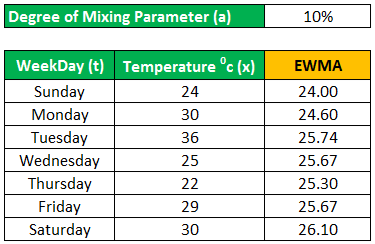

Price: the current price of the asset being analyzedĮMA_prev: the previous EMA value (or the initial EMA value, which is typically set to the simple moving average of the first n values)
#Exponential moving average formula software
The EMA calculation formula is more complex, but most charting software and trading platforms do this automatically.ĮMA = (Price - EMA_prev) x (2 / (n + 1)) + EMA_prev This means that EMAs are more responsive to price changes than SMAs. However, it is also more stable and less prone to whipsaws and false signals when the price quickly changes direction.Īn exponential moving average (EMA) is similar to an SMA but places more weight on recent prices. Therefore, it is less responsive to recent price changes and can be slower to identify new trends. The SMA is a lagging indicator because it is based on past prices. This is why it's called a moving average. Note that as each new closing price is added to the calculation, the oldest closing price is dropped, and the SMA "moves" forward in time. So the 10-day SMA for the current day would be 1.0965. Take the sum of the closing prices over the previous ten days and divide that by 10 to get the SMA for the current day.įor instance, if the closing prices for the previous ten days were: 1.1000, 1.1020, 1.1050, 1.1005, 1.0990, 1.0965, 1.0980, 1.0950, 1.0910, 1.0905, then the 10-day SMA for the current day would be: Let's say you want to calculate a 10-day SMA of the closing prices for a currency pair. The sum of Closing Prices over N periods is the total of the closing prices for the previous N periods (e.g., if you are calculating a 20-period SMA, you would add up the closing prices for the previous 20 periods) N is the number of periods you want to calculate the SMA. SMA = (Sum of Closing Prices over N periods) / N The resulting value is plotted on a chart, and this process is repeated for each subsequent day. For example, a 10-day SMA is calculated by adding up the closing prices for the past 10 days and dividing by 10. Simple Moving Average (SMA)Ī simple moving average (SMA) is calculated by adding up a set of closing prices and dividing by the number of periods used. This article will describe the key differences between these two types of moving averages, their advantages and disadvantages, and provide examples of trading strategies and observed patterns based on these indicators. There are two main types of moving averages: Simple Moving Average (SMA) and Exponential Moving Average (EMA). If you want to input the 3M CAD Zero Rates as the range input, and not the pricing, then you could modify the above to compute the two relevant prices from the returns data.Moving averages are commonly used in technical analysis to identify trends and potential entry and exit points for trading. With your data, it gives the same results as the spreadsheet calculation (within the limits of precision of the data types) Hopefully, the names of the variables will let you see the logic: Option Explicitįunction EWMA2(Prices As Range, Lambda As Double) As Doubleĭim dLogRtn As Double, dRtnSQ As Double, dWT As Double, dWtdRtn As DoubleĭLogRtn = Log(vPrices(I - 1, 1) / vPrices(I, 1)) The inputs are an array of prices, which is assumed to be in descending order as you show, and Lambda. Here's a little bit different way of doing it as a VBA function.

LogRtn = Log(vPrices(I - 1, 1) / vPrices(I, 1)) Update: using Ron Rosenfeld's solution: Option Explicitįunction EWMA(Zero As Range, Lambda As Double) As Doubleĭim LogRtn As Double, RtnSQ As Double, WT As Double, WtdRtn As Double The values I am using and the target volatility (calculated using a spreadsheet EWMA) are here. X = x + (Lambda ^ (n - c.Count)) * ((c.Value - mean) ^ 2) Mean = WorksheetFunction.Average(numbers) Function EWMA(numbers As Range, Lambda As Single) As Double However, I think there is some error in my function that I can't pinpoint, because I don't get the correct solution.

I am trying a fairly simple function to calculate an exponentially weighted moving average volatility in Excel VBA, following.


 0 kommentar(er)
0 kommentar(er)
